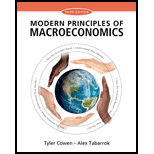
Sub part (a):
The difference in tip earnings when the server goes from mean to nice.
Sub part (a):
Answer to Problem 10TPS
$60.
Explanation of Solution
When the server is mean, he receives tip earnings of $40 per shift. When the server is nice, he is able to earn the tip of $100 per shift. Thus, when the server moves from being rude to being nice, the change in the tip earnings can be calculated as follows:
Thus, the difference between being nice and being mean is $60. Therefore, the server will earn additional $60 when he becomes nice rather than being mean.
Concept introduction:
Wages and Salaries: Wages and salaries are the main two means through which the people are paid. The wages are paid on the hourly basis for a day whereas the salaries are paid monthly.
Sub part (b):
The average tip earned when all the servers are mean.
Sub part (b):
Answer to Problem 10TPS
$40.
Explanation of Solution
When the server is mean, he receives the tip earnings of $40 per shift. When the server is nice, he is able to earn the tip of $100 per shift. Thus, when all the workers are mean, each will earn only $40 per shift. This means that the average tip earned by the server will be the same, which is $40 per shift. When all the servers are nice, each will earn $100 per shift as a tip. Therefore, when all servers are nice, each will earn $100 per shift.
Concept introduction:
Wages and Salaries: Wages and salaries are the main two means through which the people are paid. The wages are paid on the hourly basis for a day whereas the salaries are paid monthly.
Sub part (c):
The benefit from being nice from being mean.
Sub part (c):
Explanation of Solution
When the server is mean, he receives the tip earnings of $40 per shift. When the server is nice, he is able to earn the tip of $100 per shift. When some of the workers are mean and some are nice, there will be changes in the mean average and nice average. This can be calculated as follows:
|
Mean (Omitting the individual) |
Nice (Omitting the individual) | Total tips if the individual is mean | Total tips if the individual is Nice | Mean average | Nice average | Benefit of the individual from being nice |
| 0 | 9 |
|
|
|
|
|
| 5 | 4 |
|
|
|
|
|
| 9 | 0 |
|
|
|
|
|
From the above table, it can be identified that the benefit of an individual from being nice rather than being mean is $6. Thus, in pool system, the benefit for the server is only 1/10th of the benefit under normal system at any combination.
Concept introduction:
Wages and Salaries: Wages and salaries are the main two means through which the people are paid. The wages are paid on the hourly basis for a day whereas the salaries are paid monthly.
Sub part (d):
When the servers like to be more nice.
Sub part (d):
Explanation of Solution
When the server is mean, he receives the tip earnings of $40 per shift. When the server is nice, he is able to earn the tip of $100 per shift. Thus, the benefit by being nice is $60 under per shift system. When the pool system is operating, the worker will benefit only with $6.
Therefore, the worker will have more incentive to be nice under the system where they can keep their own tip. When the restaurants want to keep their customers happy, the servers should be nice. Thus, the restaurant would follow the personal tip policy rather than the pool system.
Concept introduction:
Wages and Salaries: Wages and Salaries are the main two means through which the people are paid. The wages are paid on the hourly basis for a day whereas the salaries are paid monthly.
Want to see more full solutions like this?
Chapter 7 Solutions
Modern Principles: Macroeconomics